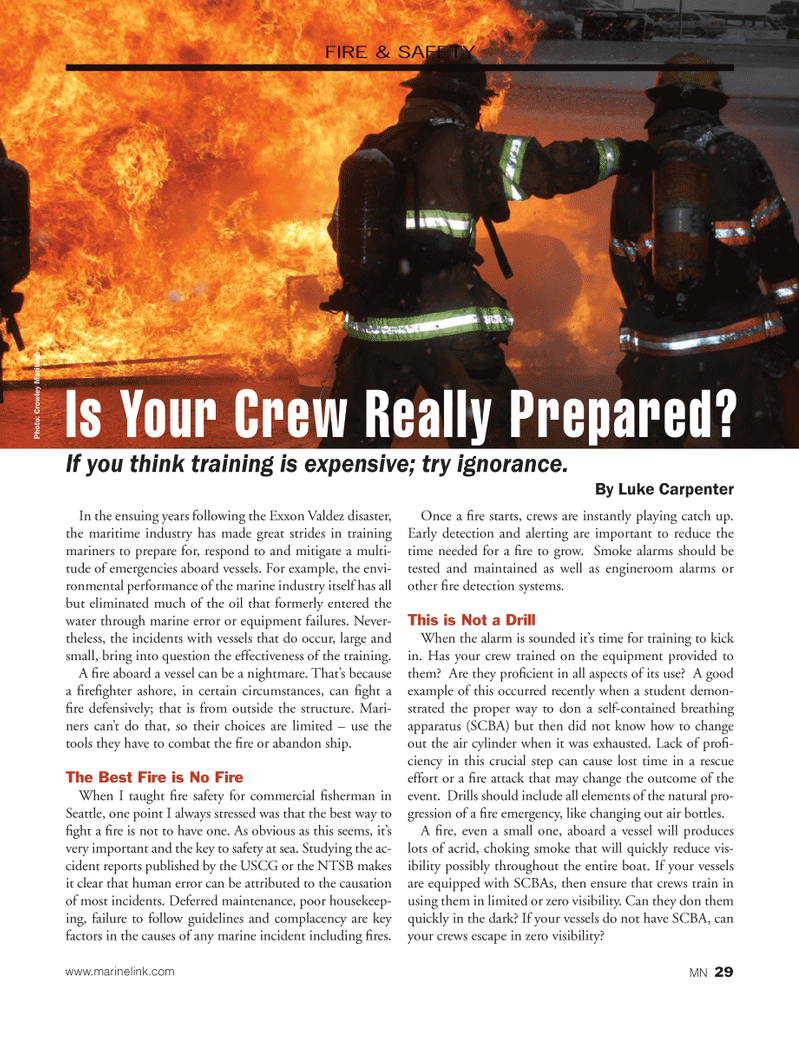
Page 29: of Marine News Magazine (February 2014)
Combat & Patrol Craft Annual
Read this page in Pdf, Flash or Html5 edition of February 2014 Marine News Magazine
In the ensuing years following the Exxon Valdez disaster, the maritime industry has made great strides in training mariners to prepare for, respond to and mitigate a multi- tude of emergencies aboard vessels. For example, the envi- ronmental performance of the marine industry itself has all but eliminated much of the oil that formerly entered the water through marine error or equipment failures. Never- theless, the incidents with vessels that do occur, large and small, bring into question the effectiveness of the training. A Þ re aboard a vessel can be a nightmare. ThatÕs because a Þ reÞ ghter ashore, in certain circumstances, can Þ ght a Þ re defensively; that is from outside the structure. Mari- ners canÕt do that, so their choices are limited Ð use the tools they have to combat the Þ re or abandon ship. The Best Fire is No Fire When I taught Þ re safety for commercial Þ sherman in Seattle, one point I always stressed was that the best way to Þ ght a Þ re is not to have one. As obvious as this seems, itÕs very important and the key to safety at sea. Studying the ac- cident reports published by the USCG or the NTSB makes it clear that human error can be attributed to the causation of most incidents. Deferred maintenance, poor housekeep- ing, failure to follow guidelines and complacency are key factors in the causes of any marine incident including Þ res. Once a Þ re starts, crews are instantly playing catch up. Early detection and alerting are important to reduce the time needed for a Þ re to grow. Smoke alarms should be tested and maintained as well as engineroom alarms or other Þ re detection systems. This is Not a DrillWhen the alarm is sounded itÕs time for training to kick in. Has your crew trained on the equipment provided to them? Are they proÞ cient in all aspects of its use? A good example of this occurred recently when a student demon- strated the proper way to don a self-contained breathing apparatus (SCBA) but then did not know how to change out the air cylinder when it was exhausted. Lack of proÞ -ciency in this crucial step can cause lost time in a rescue effort or a Þ re attack that may change the outcome of the event. Drills should include all elements of the natural pro- gression of a Þ re emergency, like changing out air bottles. A Þ re, even a small one, aboard a vessel will produces lots of acrid, choking smoke that will quickly reduce vis- ibility possibly throughout the entire boat. If your vessels are equipped with SCBAs, then ensure that crews train in using them in limited or zero visibility. Can they don them quickly in the dark? If your vessels do not have SCBA, can your crews escape in zero visibility? FIRE & SAFETYIs Your Crew Really Prepared? If you think training is expensive; try ignorance. By Luke Carpenter Photo: Crowley Maritime www.marinelink.com MN 29MN FEB14 Layout 18-31.indd 29MN FEB14 Layout 18-31.indd 291/20/2014 10:04:21 AM1/20/2014 10:04:21 AM

 28
28

 30
30
